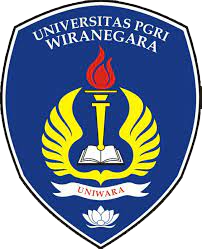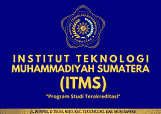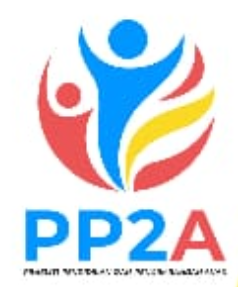Metode Inquiry: Meningkatkan Hasil Belajar Matematika Siswa SMP Pada Materi Luas Bangun Datar
Authors
-
Bayu Segara
 Universitas Ma'arif Lampung, Lampung, Indonesia
Universitas Ma'arif Lampung, Lampung, Indonesia
-
Choirudin Choirudin
 Universitas Ma'arif Lampung, Lampung, Indonesia
Universitas Ma'arif Lampung, Lampung, Indonesia
-
Agus Setiawan
 Universitas Ma'arif Lampung, Lampung, Indonesia
Universitas Ma'arif Lampung, Lampung, Indonesia
-
Muhammad Saidun Anwar
 Universitas Ma'arif Lampung
Universitas Ma'arif Lampung
-
Viky Risnanda Arif
 SMAN 1 GRATI Pasuruan, East Java, Indonesia
SMAN 1 GRATI Pasuruan, East Java, Indonesia
Keywords:
Hasil belajar, Luas bangun datar, Matematika, Model InquiryAbstract
Model pembelajaran inqury mampu meningkatkan hasil belajar siswa serta mengembangkan keterampilan bertanya, bekerjasama dalam kelompok untuk mendapatkan hasil yang baik. Masalah utama adalah nilai ulangan harian peserta didik kelas VIII untuk pelajaran matematika dengan materi luas bangun datar rendah. Tujuan dari penelitian ini adalah untuk meningkatkan pemahaman tentang luas bangun datar pada siswa kelas VIII SMP Negeri 2 Bekri. Rancangan penelitian dilakukan dalam tiga siklus, mengacu pada model Kemmis dan Mc. Taggart yaitu yang terdiri dari perencanaan, pelaksanaan tindakan, observasi dan refleksi. Subyek penelitian adalah siswa kelas VIII SMP Negeri 2 Bekri berjumlah 31 siswa pada tahun ajaran 2021/2022. Teknik pengumpulan data menggunakan teknik wawancara atau bertanya kepada siswa dan memberikan latihan soal. Teknik analisis data menggunakan analisis kuantitatif dan kualitatif. Hasil penelitian ini penggunaan metode inquiri dapat meningkatkan hasil belajar matematika siswa sebesar 86% pada materi luas bangun datar.
Downloads
References
Alkadri, R. (2021). Practicality of high school physics e-book integrated materials of meteor fall disaster mitigation based on guided inquiry model assisted google classroom. Journal of Physics: Conference Series, 1876(1). https://doi.org/10.1088/1742-6596/1876/1/012061
Amany, D. A. L., & Puteri, A. A. I. (2023). Analysis of The Relationship Between Student Interest and Written Communication in Solving Realistic Mathematics Problems. Delta-Phi: Jurnal Pendidikan Matematika, 1(1), 31–42.
AN Vidyastuti, Darmayanti, R., & Sugianto, R. (2018). The Role of Teachers and Communication Information Technology (ICT) Media in the Implementation of Mathematics Learning in the Digital Age. Al-Jabar: Jurnal Pendidikan Matematika, 9(2), 221–230.
Anhar, J., Darmayanti, R., & Usmiyatun, U. (2023). Pengaruh Kompetensi Guru Agama Islam Terhadap Implementasi Manajemen Sumber Daya Manusia Di Madrasah Tsanawiyah. Assyfa Journal of Islamic Studies, 1(1), 13–23. https://www.journal.assyfa.com/index.php/ajis/index
Anjarwati, S., Darmayanti, R., & Khoirudin, M. (2023). Development of “Material Gaya” Teaching Materials Based on Creative Science Videos (CSV) for Class VIII Junior High School Students. Jurnal Edukasi Matematika Dan Sains), 11(1), 163–172. https://doi.org/10.25273/jems.v11i1.14347
Anwar, M. S., Choirudin, C., Ningsih, E. F., Dewi, T., & Maseleno, A. (2019). Developing an Interactive Mathematics Multimedia Learning Based on Ispring Presenter in Increasing Students’ Interest in Learning Mathematics. Al-Jabar : Jurnal Pendidikan Matematika, 10(1), 135–150. https://doi.org/10.24042/ajpm.v10i1.4445
Arif, V. R., Afnan, M., Usmiyatun, U., & Lestari, C. Y. (2023). Development of Social Studies Animation Video (S2AV) Teaching Materials on the Material" Plurality of Indonesian Society" for Junior High School Students. Assyfa Learning Journal, 1(1), 1–11.
Cahyadi, M. R., & Ariansyah, F. (2023). Analysis of Skills Using Pattern Finding Strategies in Solving Mathematical Problems in View of Gender Differences. Delta-Phi : Jurnal Pendidikan Matematika, 1(1), 12–22.
Caskurlu, S. (2021). The qualitative evidence behind the factors impacting online learning experiences as informed by the community of inquiry framework: A thematic synthesis. Computers and Education, 165. https://doi.org/10.1016/j.compedu.2020.104111
Chen, C. H. (2020). Inquiry-Enhanced Digital Game-Based Learning: Effects on Secondary Students’ Conceptual Understanding in Science, Game Performance, and Behavioral Patterns. Asia-Pacific Education Researcher, 29(4), 319–330. https://doi.org/10.1007/s40299-019-00486-w
Choi, W. (2022). A Molecular Inquiry into the Role of Antibody-Drug Conjugates in Bacillus Calmette-Guérin-exposed Non–muscle-invasive Bladder Cancer. European Urology, 81(2), 138–142. https://doi.org/10.1016/j.eururo.2021.10.009
Choirudin, C., Anwar, M. S., Azizah, I. N., Wawan, W., & Wahyudi, A. (2021). Pengembangan LKPD Matematika Berbasis Kaligrafi dengan Pendekatan Guided Discovery Learning. Jurnal Pendidikan Matematika (JPM), 7(1), 52. https://doi.org/10.33474/jpm.v7i1.6738
Choirunnisa, A., Nurhanurawati, N., Dahlan, S., Choirudin, C., & Anwar, M. S. (2022). Development of Islamic Value-Based Mathematics Teaching Materials to Improve Students’ Understanding of Mathematical Concepts. Jurnal Analisa, 8(1), 11–20. https://doi.org/10.15575/ja.v8i1.17073
Chu, S. K. W., Reynolds, R. B., Tavares, N. J., Notari, M., & Lee, C. W. Y. (2016). 21st century skills development through inquiry-based learning: From theory to practice. 21st Century Skills Development Through Inquiry-Based Learning: From Theory to Practice, January, 1–204. https://doi.org/10.1007/978-981-10-2481-8
Costouros, T. (2020). Jigsaw cooperative learning versus traditional lectures: Impact on student grades and learning experience. Teaching and Learning Inquiry, 8(1), 154–172. https://doi.org/10.20343/TEACHLEARNINQU.8.1.11
Darmayanti, R. (2023). Gema Cow-Pu: Development of Mathematical Crossword Puzzle Learning Media on Geometry Material on Middle School Students’ Critical Thinking Ability. Assyfa Learning Journal, 1(1), 37–48.
Darmayanti, R., Nguyen, T., & Serpe, A. (2023). Gema Cow-Pu: Development of Mathematical Crossword Puzzle Learning Media on Geometry Material on Middle School Students’ Critical Thinking Ability. Assyfa Learning Journal, 1(1), 37–48.
Darmayanti, R., Sugianto, R., Baiduri, B., Choirudin, C., & Wawan, W. (2022a). Digital comic learning media based on character values on students’ critical thinking in solving mathematical problems in terms of learning styles. Al-Jabar: Jurnal Pendidikan Matematika, 13(1), 49–66.
Darmayanti, R., Sugianto, R., Baiduri, Choirudin, & Wawan. (2022b). Digital comic learning media based on character values on students’ critical thinking in solving mathematical problems in terms of learning styles. Al-Jabar: Jurnal Pendidikan Matematika, 13(1), 49–66. http://ejournal.radenintan.ac.id/index.php/al-jabar/index
Daskalaki, M. (2015). Are Entrepreneurship, Communities, and Social Transformation Related? Journal of Management Inquiry, 24(4), 419–423. https://doi.org/10.1177/1056492615579012
Decock, L. (2021). Conceptual change and conceptual engineering: the case of colour concepts. Inquiry (United Kingdom), 64(1), 168–185. https://doi.org/10.1080/0020174X.2020.1784783
Deterding, S. (2019). Gamification in Management: Between Choice Architecture and Humanistic Design. Journal of Management Inquiry, 28(2), 131–136. https://doi.org/10.1177/1056492618790912
DP Utomo, TZ Amaliyah, Darmayanti, R., Usmiyatun, U., & Choirudin, C. (2023). Students’ Intuitive Thinking Process in Solving Geometry Tasks from the Van Hiele Level. JTAM (Jurnal Teori Dan Aplikasi Matematika), 7(1), 139–149. https://doi.org/10.31764/jtam.v7i1.11528
Fauza, M., Inganah, S., Sugianto, R., & Darmayanti, R. (2023). Urgensi Kebutuhan Komik: Desain Pengembangan Media Matematika Berwawasan Kearifan Lokal di Medan. Delta-Phi: Jurnal Pendidikan Matematika, 1(2), 130–146. http://www.journal.com/index.php/dpjpm
Fijar, N. A., Saptono, S., & Masturi, M. (2019). Implementation of Guided Inquiry Learning To Improve The Critical Thinking Skills of Junior High School Students. Journal of Innovative Science Education, 8(3).
Gajić, M. M., Miljanović, T. B., Babić-Kekez, S. S., Županec, V. D., & Jovanović, T. T. (2021). Correlations between teaching strategies in biology, learning styles, and student school achievement: Implications for inquiry based teaching. Journal of Baltic Science Education, 20(2). https://doi.org/10.33225/jbse/21.20.184
Gazali, R. Y. (2016). Pembelajaran matematika yang bermakna. Math Didactic: Jurnal Pendidikan Matematika, 2(3), 181–190. https://doi.org/10.33654/math.v2i3.47
Hasanah, N., In’am, A., Darmayanti, R., Choirudin, C., Nurmalitasari, D., & Usmiyatun, U. (2022). DEVELOPMENT OF AL-QUR’AN CONTEXT MATH E-MODULE ON INVERS FUNCTION MATERIALS USING BOOK CREATOR APPLICATION. AKSIOMA: Jurnal Program Studi Pendidikan Matematika, 11(4), 3502. https://doi.org/10.24127/ajpm.v11i4.5647
Hidayat, W., & Aripin, U. (2019). The improvement of students’ mathematical understanding ability influenced from argument-driven inquiry learning. Journal of Physics: Conference Series, 1157(3). https://doi.org/10.1088/1742-6596/1157/3/032085
Hong, J. C. (2021). Critical attitude and ability associated with students’ self-confidence and attitude toward “predict-observe-explain” online science inquiry learning. Computers and Education, 166. https://doi.org/10.1016/j.compedu.2021.104172
Hosbein, K. N. (2021). Tracking Student Argumentation Skills across General Chemistry through Argument-Driven Inquiry Using the Assessment of Scientific Argumentation in the Classroom Observation Protocol. Journal of Chemical Education, 98(6), 1875–1887. https://doi.org/10.1021/acs.jchemed.0c01225
Hudha, A. M., Ullah, K., & Darmayanti, R. (2023). Osmosis: Chewy naked egg, in or out? Journal of Advanced Sciences and Mathematics Education, 3(1), 1–14. https://doi.org/10.58524/jasme.v3i1.193
Humaidi, N., Darmayanti, R., & Sugianto, R. (2022). Challenges of Muhammadiyah’s Contribution in Handling Covid-19 in The MCCC Program in Indonesia. Khazanah Sosial, 4(1), 176–186. https://doi.org/10.15575/ks.v4i1.17201
In’am, A., Darmayanti, R., Hariyadi, A., & Mardiningrum, W. W. (2023). MICROTEACHING: Analysis of the Readiness of Prospective Mathematics Teacher Students in Teaching Function Material. Delta-Phi: Jurnal Pendidikan Matematika, 1(3).
Inganah, S., Choirudin, & Rizki, N. (2023). Integration of Islamic Values , Mathematics , and Career Readiness Competencies of Prospective Teachers in Islamic Universities. Delta-Phi : Jurnal Pendidikan Matematika, 1(1), 23–30.
Inganah, S., Darmayanti, R., & Rizki, N. (2023). Problems, Solutions, and Expectations: 6C Integration of 21 st Century Education into Learning Mathematics. JEMS (Journal of Mathematics and Science Education), 11(1), 220–238. https://doi.org/10.25273/jems.v11i1.14646
Jannah, Z. B., Islahudin, I., & Darmayanti, N. . W. S. (2018). PENGEMBANGAN MODUL FISIKA BILINGUAL MATERI HUKUM NEWTON PADA SISWA SMA KELAS X UNTUK MENINGKATKAN MOTIVASI BELAJAR FISIKA TAHUN AJARAN 2017/2018. ORBITA: Jurnal Kajian, Inovasi Dan Aplikasi Pendidikan Fisika, 4(2). https://doi.org/10.31764/orbita.v4i2.575
Jansson, M. (2021). Online question and answer sessions: How students support their own and other students’ processes of inquiry in a text-based learning environment. Internet and Higher Education, 51. https://doi.org/10.1016/j.iheduc.2021.100817
Jayanti, E. F., Choirudin, & Anwar, M. S. (2023). Application of the Mind Mapping Learning Model to Improve Understanding of Mathematics Concepts in Building Space Materials. Delta-Phi : Jurnal Pendidikan Matematika, 1(1), 43–56.
Kalogeropoulos, P. (2021). Learning Mathematics From Home During COVID-19: Insights From Two Inquiry-Focussed Primary Schools. Eurasia Journal of Mathematics, Science and Technology Education, 17(5), 1–16. https://doi.org/10.29333/ejmste/10830
Kamarullah, K. (2017). Pendidikan Matematika Di Sekolah Kita. Al Khawarizmi: Jurnal Pendidikan Dan Pembelajaran Matematika, 1(1), 21. https://doi.org/10.22373/jppm.v1i1.1729
Karim, S., & Zoker, E. M. (2023). Technology in Mathematics Teaching and Learning: An Impact Evaluation in Selected Senior Schools in Masingbi Town. Assyfa Learning Journal, 1(2), 60–72.
Khoiriyah, B., Darmayanti, R., & & Astuti, D. (2022). Design for Development of Canva Application-Based Audio-Visual Teaching Materials on the Thematic Subject “Myself (Me and My New Friends)” Elementary School Students. Jurnal Pendidikan Dan Konseling (JPDK), 4(6), 6287–6295.
Kusumah, R. G. T., Walid, A., Pitaloka, S., Dewi, P. S., & Agustriana, N. (2020). Penerapan Metode Inquiry Sebagai Usaha Untuk Meningkatkan Hasil Belajar Ipa Pada Materi Penggolongan Hewan Di Kelas Iv Sd Seluma. Jurnal Pendidikan Matematika Dan IPA, 11(1), 142–153. https://doi.org/10.26418/jpmipa.v11i1.34708
Lameras, P. (2021). Science teachers’ experiences of inquiry-based learning through a serious game: a phenomenographic perspective. Smart Learning Environments, 8(1). https://doi.org/10.1186/s40561-021-00152-z
Landers, R. (2019). Gamification Misunderstood: How Badly Executed and Rhetorical Gamification Obscures Its Transformative Potential. Journal of Management Inquiry, 28(2), 137–140. https://doi.org/10.1177/1056492618790913
Lee, V. S. (2023). What is Inquiry-Guided Learning? Teaching and Learning through Inquiry: A Guidebook for Institutions and Instructors, 3–16. https://doi.org/10.4324/9781003447351-2
Lin, X. F. (2022). Effects of a contextualised reflective mechanism-based augmented reality learning model on students’ scientific inquiry learning performances, behavioural patterns, and higher order thinking. Interactive Learning Environments. https://doi.org/10.1080/10494820.2022.2057546
Liu, C. (2021). Analysing user reviews of inquiry-based learning apps in science education. Computers and Education, 164. https://doi.org/10.1016/j.compedu.2020.104119
Lo, J. H. (2021). The study of ar-based learning for natural science inquiry activities in taiwan’s elementary school from the perspective of sustainable development. Sustainability (Switzerland), 13(11). https://doi.org/10.3390/su13116283
Long, A. (2016). Student response to “defining pedagogic expertise: Students and new lecturers as co-developers in learning and teaching.” Teaching and Learning Inquiry, 4(2).
Mabingo, A., Ssemaganda, G., Sembatya, E., & Kibirige, R. (2020). Decolonizing Dance Teacher Education: Reflections of Four Teachers of Indigenous Dances in African Postcolonial Environments. Journal of Dance Education, 20(3). https://doi.org/10.1080/15290824.2020.1781866
Maison, Tant, T., Kurniawan, D. A., Sukarni, W., Erika, & Hoyi, R. (2021). Assessing students’ attitudes towards physics through the application of inquiry and jigsaw cooperative learning models in high schools. International Journal of Instruction, 14(4). https://doi.org/10.29333/iji.2021.14426a
Manizar, E. (2015). Peran Guru sebagai Motivator dalam Belajar. Jurnal Pendidikan Agama Islam, 1(2), 171–188.
Marchy, F., Murni, A., Kartini, & Muhammad, I. (2022). The Effectiveness of Using Problem Based Learning (PBL) in Mathematics Problem Solving Ability for Junior High School Students. AlphaMath Journal of Mathematics Education, 8(2), 185–198. https://doi.org/10.30595/alphamath.v8i2.15047
Mayani, I., Suripah, & Muhammad, I. (2022). Analysis of Students’ Errors in Solving Statistical Problems: A Case of 8th Grade Students at SMPN 4 Siak Hulu, Indonesia. Jurnal Pendidikan Mipa, 23(4), 1826–1838. https://doi.org/10.23960/jpmipa/v23i2.pp1827-1838
MM Effendi, Darmayanti, R., & In’am, A. (2022). Strengthening Student Concepts: Problem Ethnomatmatics Based Learning (PEBL) Singosari Kingdom Historical Site Viewed from Learning Styles in the Middle School Curriculum. Indomath: Indonesia Mathematics Education, 5(2), 165–174. https://jurnal.ustjogja.ac.id/index.php/
Mustakim, A., Wawan, W., Ngaliyah, J., & Darmayanti, R. (2023). Quantum Teaching Model: Untuk Meningkatkan Hasil Belajar Matematika Siswa MTs. Jurnal Penelitian Tindakan Kelas, 1(1), 10–18. https://www.journal.assyfa.com/index.php/JPTK/
MZ Mubarok, Mispani, M Yusuf, & R Darmayanti. (2023). Efforts to improve tajwid learning using the An-Nahdliyah method in Diniyah students. Assyfa Journal of Islamic Studies, 1(1), 99–109.
Nado, J. (2021). Conceptual engineering via experimental philosophy. Inquiry (United Kingdom), 64(1–2). https://doi.org/10.1080/0020174X.2019.1667870
Nasiha, W., Afifah, N., & Amir, A. N. (2023). Design of a website-based arabic typing application for students of arabic language education program at university. Assyfa Learning Journal, 1(1), 12–24.
Nasution, V. Y., Widestra, R. A., & Yulkifli, Y. (2021). Validity of Student Worksheets using Inquiry Based Learning Models with Science Technology Society Approach for Physics Learning. International Journal of Progressive Sciences and Technologies, 25(1). https://doi.org/10.52155/ijpsat.v25.1.2681
Nisa, H., Anwar, M. S., & Wardana, M. R. F. (2023). Implementasi Etnomatemtika Berbasis Alat Kesenian Rebana Dalam Pembelajaran Bangun Ruang. Delta-Phi: Jurnal Pendidikan Matematika, 1(3), 205–210.
PAD Rizqi, Darmayanti, R., Sugianto, R., & Muhammad, I. (2023). Problem Solving Analysis Through Tests in View Of Student Learning Achievement. Indonesian Journal of Learning and Educational Studies, 1(1), 53–63. https://jurnal.piramidaakademi.com/index.php/ijles
Pradana, M. D., & Uthman, Y. (2023a). Development of Aqidah Akhlak Learning Media" Board Game Based on Education Fun on the Theme of Commendable Morals (E-Fun A2M)" for High School Students. Assyfa Learning Journal, 1(1), 25–36.
Pradana, M. D., & Uthman, Y. O. O.-O. (2023b). Development of Aqidah Akhlak Learning Media" Board Game Based on Education Fun on the Theme of Commendable Morals (E-Fun A2M)" for High School Students. Assyfa Learning Journal, 1(1), 25–36.
Pratama, A. A., Wardana, M. R. F., & Fanani, A. A. (2023). Analisis Kemampuan Berfikir Kreatif Matematis Siswa Ditinjau Dari Segi Gender. Delta-Phi: Jurnal Pendidikan Matematika, 1(2), 172–182.
Qomariyah, S., Darmayanti, R., Rosyidah, U., & Ayuwanti, I. (2023). Indicators and Essay Problem Grids on Three-Dimensional Material: Development of Instruments for Measuring High School Students’ Mathematical Problem-Solving Ability. Jurnal Edukasi Matematika Dan Sains, 11(1), 261–274. https://doi.org/10.25273/jems.v11i1.14708
Rachmawati, L. N., Sah, R. W. A., & Hasanah, S. N. (2023). Newman and Scaffolding Stages in Analyzing Student Errors in Solving Algebraic Problems. Delta-Phi : Jurnal Pendidikan Matematika, 1(1), 1–11.
Rahayu, D. P., & Pamelasari, S. D. (2018). Critical thinking ability junior high school student ’ s with process oriented guided inquiry model. International Conference on Mathematics and Science Education, 3.
Rahmah, K., Inganah, S., Darmayanti, R., Sugianto, R., & Ningsih, E. F. (2022). Analysis of Mathematics Problem Solving Ability of Junior High School Students Based on APOS Theory Viewed from the Type of Kolb Learning Style. INdoMATH: Indonesia Mathematics Education, 5(2), 109–122. https://indomath.org/index.php/
Rahman, M. A. (2023). Professional Development in an institution through GROW Model. Assyfa Learning Journal, 1(2).
Ramadhaniyati, R., Dwi, K., Siregar, P., Muhammad, I., & Triansyah, F. A. (2023). Guide Discovery Learning ( GDL ) in Education : A Bibliometric Analysis. Journal on Education, 05(04), 11473–11484.
Rofiah, N., Anwar, M. S., & Ridho’i, A. V. (2023). Analisis Kesulitan Belajar Matematika ditinjau dari Motivasi Belajar Siswa. Delta-Phi: Jurnal Pendidikan Matematika, 1(3).
Roller, R. M. (2021). Inquiry-Based Laboratories Using Paper Microfluidic Devices. Journal of Chemical Education, 98(6), 1946–1953. https://doi.org/10.1021/acs.jchemed.1c00214
Safitri, M. A. D. (2020). Mind mapping in argument-driven inquiry (ADI) model to improve students’ critical thinking skills with a different prior knowledge in the topic of reaction rate. AIP Conference Proceedings, 2215. https://doi.org/10.1063/5.0000755
Sah RWA, Darmayanti, R., & Maryanto BPA. (2022). Updating Curriculum Through 21st-Century Learning Design. Seminar Nasional Teknologi Pembelajaran, 2(1). http://snastep.um.ac.id/pub/index.php/proceeding/indexKeahliandanPerformaPakardalamTeknologiPendidikanuntuk
Santiago, P., Alves, F. R. V, & Darmayanti, R. (2023). GeoGebra in the light of the Semiotic Representation Registers Theory: an international Olympic didactic sequence. Assyfa Learning Journal, 1(2), 73–90.
Santiago, P. V. da S. (2023). Didactic Engineering Supporting the Use of Gamification Applied to the Teaching of Arithmetic Operations. Delta-Phi : Jurnal Pendidikan Matematika, 1(1), 57–71.
Sanusi, N., Triansyah, F. A., Muhammad, I., & Susanti, S. (2023). Analisis Bibliometrik: Penelitian Communication Skills Pada Pendidikan Tinggi. JIIP - Jurnal Ilmiah Ilmu Pendidikan, 6(3), 1694–1701. https://doi.org/10.54371/jiip.v6i3.1763
Schabas, A. (2023). Game-Based Science Learning: What are the Problems with Teachers Practicing It in Class? Assyfa Learning Journal, 1(2).
Schwartz, M. (2017). From the Ordinary to Corruption in Higher Education. Journal of Management Inquiry, 26(3), 270–279. https://doi.org/10.1177/1056492616674828
Sekaryanti, R., Darmayanti, R., Choirudin, C., Usmiyatun, U., Kestoro, E., & Bausir, U. (2023). Analysis of Mathematics Problem-Solving Ability of Junior High School Students in Emotional Intelligence. Jurnal Gantang, 7(2), 149–161. https://doi.org/10.31629/jg.v7i2.4944
Siagian, R. E. F., & Nurfitriyanti, M. (2015). Metode Pembelajaran Inquiry dan Pengaruhnya terhadap Hasil Belajar Matematika ditinjau dari Kreativitas Belajar. Formatif: Jurnal Ilmiah Pendidikan MIPA, 2(1), 35–44. https://doi.org/10.30998/formatif.v2i1.85
Simonton, K. L., Layne, T. E., & Irwin, C. C. (2021). Project-based learning and its potential in physical education: an instructional model inquiry. Curriculum Studies in Health and Physical Education, 12(1). https://doi.org/10.1080/25742981.2020.1862683
Sudarsana, I. K. (2016). Peningkatan Mutu Pendidikan Luar Sekolah Dalam Upayapembangunan Sumber Daya Manusia. Jurnal Penjaminan Mutu, 1(1), 1. https://doi.org/10.25078/jpm.v1i1.34
Sugianto, R., Cholily, Y. M., Darmayanti, R., Rahmah, K., & Hasanah, N. (2022). Development of Rainbow Mathematics Card in TGT Learning Model for Increasing Mathematics Communication Ability. Kreano: Jurnal Matematika Kreatif-Inovatif, 13(2), 221–234. http://journal.unnes.ac.id/nju/index.php/kreano
Sugianto, R., Darmayanti, R., Aprilani, D., Amany, L., Rachmawati, L. N., Hasanah, S. N., & Aji, F. B. (2017). Experiment on Ability to Understand Three-Dimensional Material Concepts Related to Learning Styles Using the Geogebra-Supported STAD Learning Model Abstra ct. Al-Jabar: Jurnal Pendidikan Matematika, 8(2), 205–212.
U Zahroh, NI Rachmawati, R Darmayanti, & T Tantrianingrum. (2023). “Guidelines” for collaborative learning in 21st century education at Madrasah Tsanawiyah. Assyfa Journal of Islamic Studies, 1(2).
Wang, H. H. (2022). The role of structured inquiry, open inquiry, and epistemological beliefs in developing secondary students’ scientific and mathematical literacies. International Journal of STEM Education, 9(1). https://doi.org/10.1186/s40594-022-00329-z
Wang, X. (2022). Learners’ perceived AI presences in AI-supported language learning: a study of AI as a humanized agent from community of inquiry. Computer Assisted Language Learning. https://doi.org/10.1080/09588221.2022.2056203
Winson, V. R. V, Arunkumar, V., & Rao, D. P. (2023). Exploring the Landscape of Teaching and Learning English as a Second Language in India. Assyfa Learning Journal, 1(2).
Yang, W. (2019). Content analysis of inquiry-based tasks in high school biology textbooks in Mainland China. International Journal of Science Education, 41(6), 827–845. https://doi.org/10.1080/09500693.2019.1584418
Yulianti, D. (2016). Inquiry-based science comic physics series integrated with character education. Jurnal Pendidikan IPA Indonesia, 5(1), 38–44. https://doi.org/10.15294/jpii.v5i1.5787

Published
How to Cite
Issue
Section
License
Copyright (c) 2023 Jurnal Penelitian Tindakan Kelas

This work is licensed under a Creative Commons Attribution-ShareAlike 4.0 International License.

















